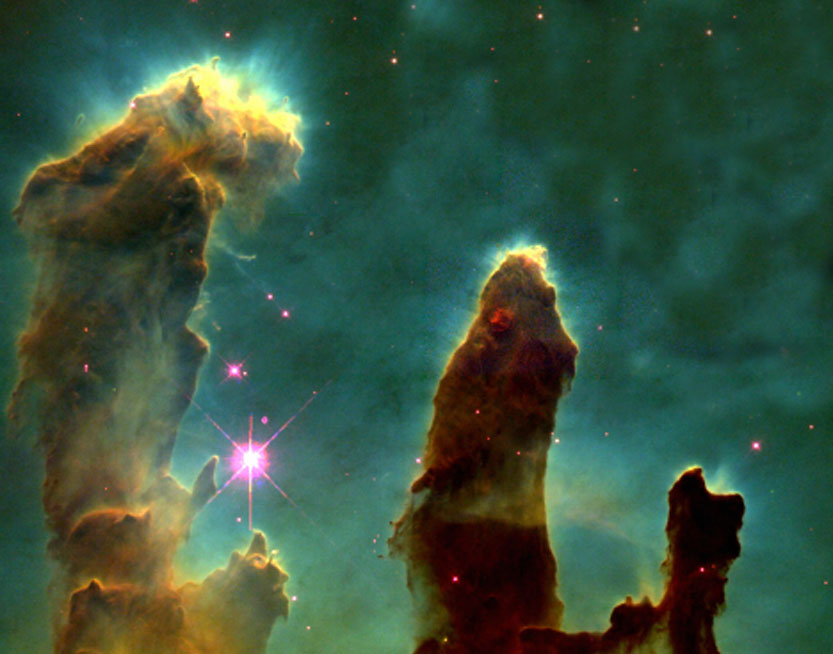Large Deposits of Water-Ice Found on Mars
By Evan FinnesOn November 20th, 2008, NASA confirmed that the Mars Reconnaissance Orbiter has discovered ancient glaciers of water-ice preserved under a layer or dust and rock. These subsurface glaciers are located at altitudes much lower than any previously discovered layers of ice, and also contain more water-ice than any other region on Mars, including the poles.
These glaciers were discovered underneath a formation that had been puzzling geologists for years. These formations are known as “aprons” because of the way they gently slope upwards. The glaciers were discovered after ground penetrating radars were pointed at these “aprons” because the radio waves were reflected without a significant loss of energy shortly after penetrating the surface. The radio waves that are not reflected travel through these formations with an apparent velocity, which is consistent with the composition of water-ice.
Hundreds of these apron-like features are located in latitude bands between 35 and 60 degrees on either side of the Martian equator. They are also commonly located beneath cliffs and are typically tens of kilometers long, and may be the remnants of a giant ice sheet, which may have at one time engulfed these mid-altitude regions. Many scientists believe that Mars was once tilted in such a fashion that the poles pointed toward the Sun, leaving the mid-latitude regions in a much cooler climate. This discovery offers proof to this hypothesis.
Studying these ice-sheets could help us understand processes that effect climate change, which is a poorly understood phenomenon, here on Earth. Our last glacial Maximum occurred about 20,000 years ago, when much of the North American and Eurasian continents were covered in an ice sheet over 3 kilometers thick. There are many factors which are thought to cause the onset of an ice age, such as: changes in the atmosphere, tectonic geography, variation in the Earth’s orbit, and variations in solar energy. The changes in the atmosphere which effect the onset of glaciers is not well understood, although, there is some proof that CO2 levels shrink during the onset of an ice age, and increase during interglacial periods. The effects of increased CO2 on the climate have long been a subject of great debate. Tectonic geography affects the onset of ice ages by arranging the continents in such a way that they prevent the flow of warm water from the equator to the poles; this allows the formation of ice sheets. These ice-sheets increase the planets albedo, which decreases the amount of solar radiation, which is absorbed. This decrease in absorbed energy allows the ice sheets to expand. There are three known configurations which block or reduce this flow of warm water–two of which exist today. A continent sits on top of a pole, such as Antarctica. Or a polar sea, such as the Arctic Ocean, is nearly land-locked. The third configuration consists of a single mass continent which covers much of the equator. Such a mass continent existed between 850 and 635 million years ago during the Cryogenian period, and was called Rodinia. Variations in the Earth’s orbit, called Milankovitch cycles, suggests that major ice ages occur every 100,000 years due to periodic changes in Earth’s eccentricity, axial tilt, and orbital periods; however, how these variations effect the climate are not well understood.
The discovery of these large volumes of water-ice on Mars will be very important to the future colonization, and manned missions to mars. This ice will serve as drinking water, and as a source of energy, which will be used in hydrogen fueled vehicles. This will defiantly reduce costs for such future missions because fewer supplies will have to be shipped to the red planet.
On Earth, such buried glaciers in Antarctica preserve traces of ancient organisms. So these Martian glaciers might also serve as a place to look for fossil evidence of past life on Mars. In addition to fossil life, localized heating due to volcanism may have melted some ice, which could provide an environment for microorganisms to evolve.
The discovery of subsurface glaciers on Mars will help us understand the processes which evoke climate change on Earth, provide a place to gather food and fuel for future missions to Mars, and could be one of the best places to look for signs of ancient organisms. Indeed, these will be places which will be thoroughly explored by rovers, Landers, and eventually, by mankind.

